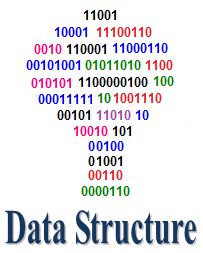I-Tech System provide Data Structure course in Nashik for students of all streams. Data structure is a way of organizing and storing data in a computer so that it can be used effectively. Data are nothing but a collection of facts and figures, or we can say that data are values or a set of values that are in a particular format. A data item refers to a single set of values. Data items are then after classified into sub-items which are the group of items which are not being called a plain elementary form of items. For example where the name of the student may be divided into three sub-items namely: first name, middle name and last name. But the ID which is assigned to a student would normally be considered as a single item.
Data Structure Course Contents:

–Introduction
–Array
–Pointer
–Function
–Structure
–Pointer, Structure with Function
–Stack
–Applications of Stack
–Linear Queue & its Operations
–Circular Queue & its Operation
–Linked List (Single ,Double ,Circular,
Header)
–Tree
–Graph
–Hashing & Searching
–Sorting
Data Structure Syllabus in Details
Introduction:
–Concept Data Structure
–Example
–Need of Data structure
–Advantages of using DS
Algorithm & Pseudocode:
–Algorithm Definition
–Characteristics of algorithm
–Elements of algorithm
–Pseudocode example
–Difference of Algorithm & Pseudocode
Function:
–What is function
–Types of function
–How function works
–Function recursion and how it works.
Array:
–Concept of Array
–Types of array
–Basic Programs
–Array with Functions
–Single & 2-dimensional array in function argument.
Pointer:
–Pointer Basics
–Pointer with functions
–Call by reference
–Array of pointers & pointer to array & Programs
Structure:
–Understanding about Structure
–Pointer structure variable
–Structure as function argument
–using call by member value
–hole structure and call by
–passing reference of structure.
Stack:
–Operations on Stack
–Array & Linked Representation
–Programs on stack
–Push & Pop operations
–Traversing.
Applications of Stack :
–Arithmetic Expression Evaluation
–Notations, Infix
–Postfix, Prefix
–Conversion infix to post fix
–Conversion postfix to infix
–Evaluation of Postfix and Pre fix using stack.
Queue:
–Operations on Queue
–Array & Linked Representation
–Programs on stack
–Insert & Delete operations
–Circular queue
–Rrepresentation
–Deque
–Priority Queue
–Application of queue.
LinkedList:
–Concept of linked list
–Difference of linklist & array
–Single linked list
–Representation
–Operations
–Traversing
–Insertion(first node, last node, at a position, after a node value)
–Deletion(first node, last node, at a position, after a node value)
–Double linked list
–Representation
–Operations, traversing
–Insertion (first node, last node, at a position, after a node value)
–Deletion (first node, last node, at a position, after a node value)
–Circular link list & header link list example
Tree:
–Tree terminology
–Binary tree
–Complete Binary Tree
–Binary search tree
–Tree Traversals
–Creation of Binary Tree from traversal methods
–Expression Tree & expression Manipulation
–Binary Search Tree
–Insertion & deletion in BST(Program)
–AVL Tree, M-way Search Tree
–B+ tree, Insertion & deletion.
Graph:
–Graph terminology
–Representation of graphs
–Path matrix
–Graph Traversal
–BFS (breadth first search)
–DFS (depth first search)
–Minimum spanning Tree
–Kruskal’s Algorithm & Prim’s Algorithm
–Warshall’s algorithm (shortest path
algorithm).
Hashing & Searching:
–Linear and binary search methods
–Hash functions
–Hashing techniques & Chaining.
Sorting:
–Bubble sort
–Selection sort
–Insertion sort
–Quick sort
–Merge sort
–Heap sort
–Radix sort
